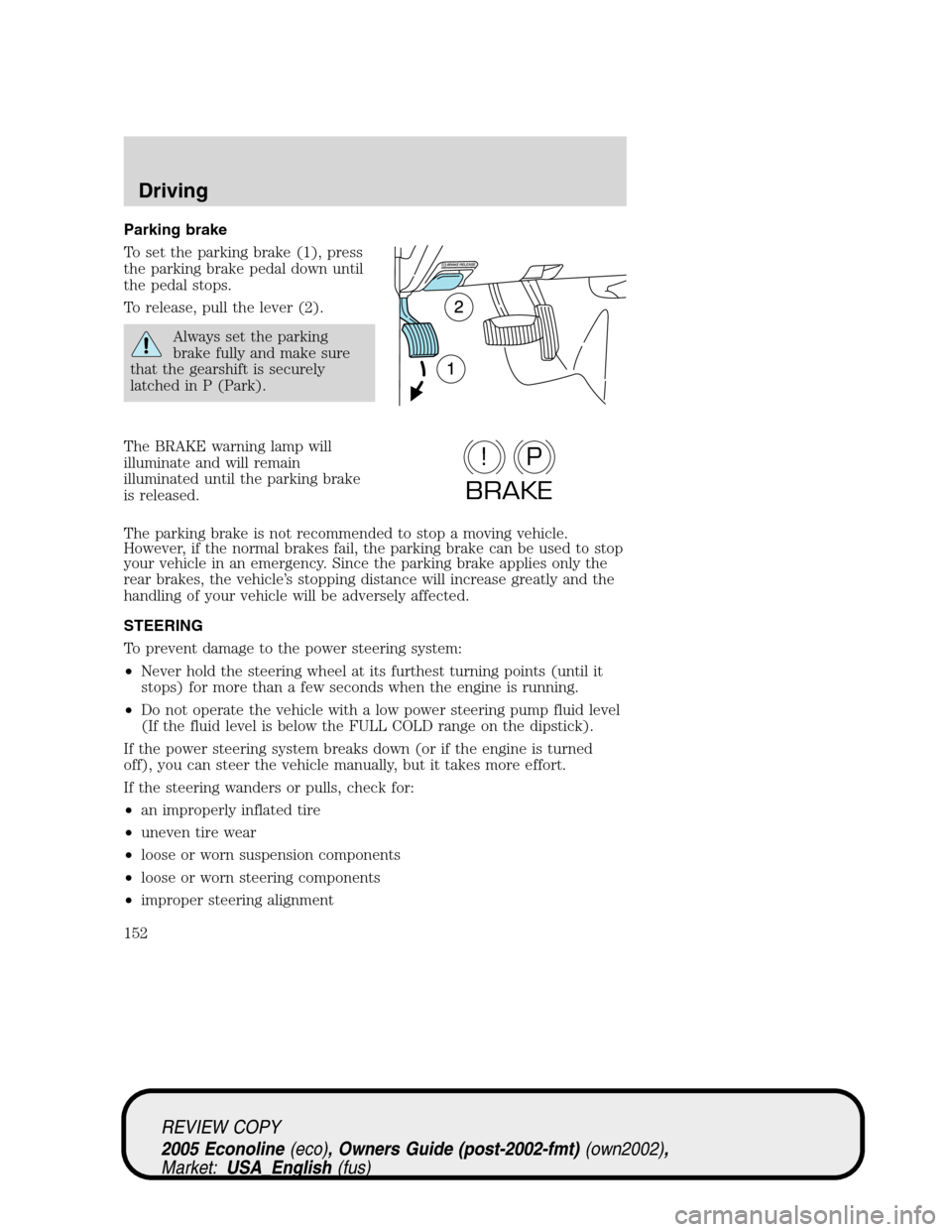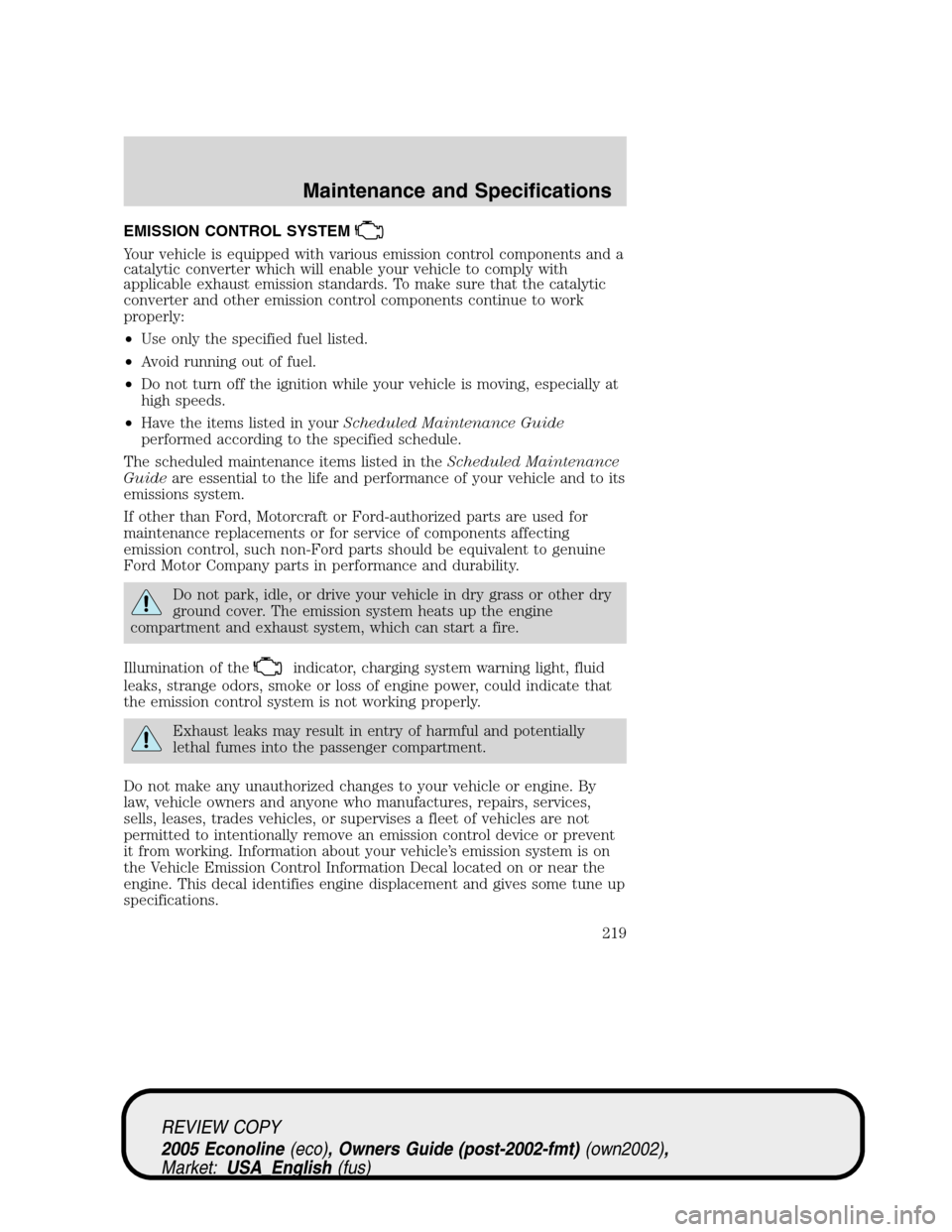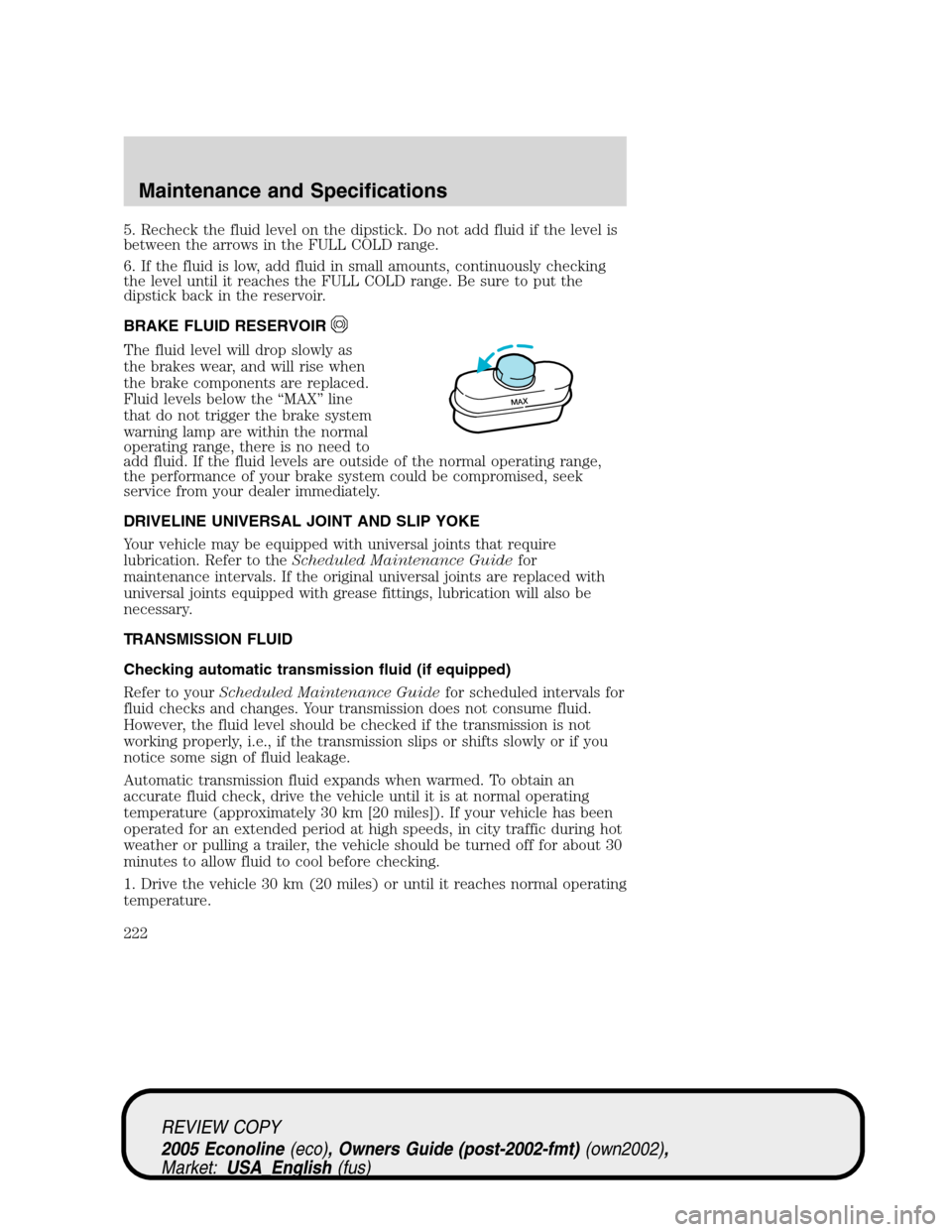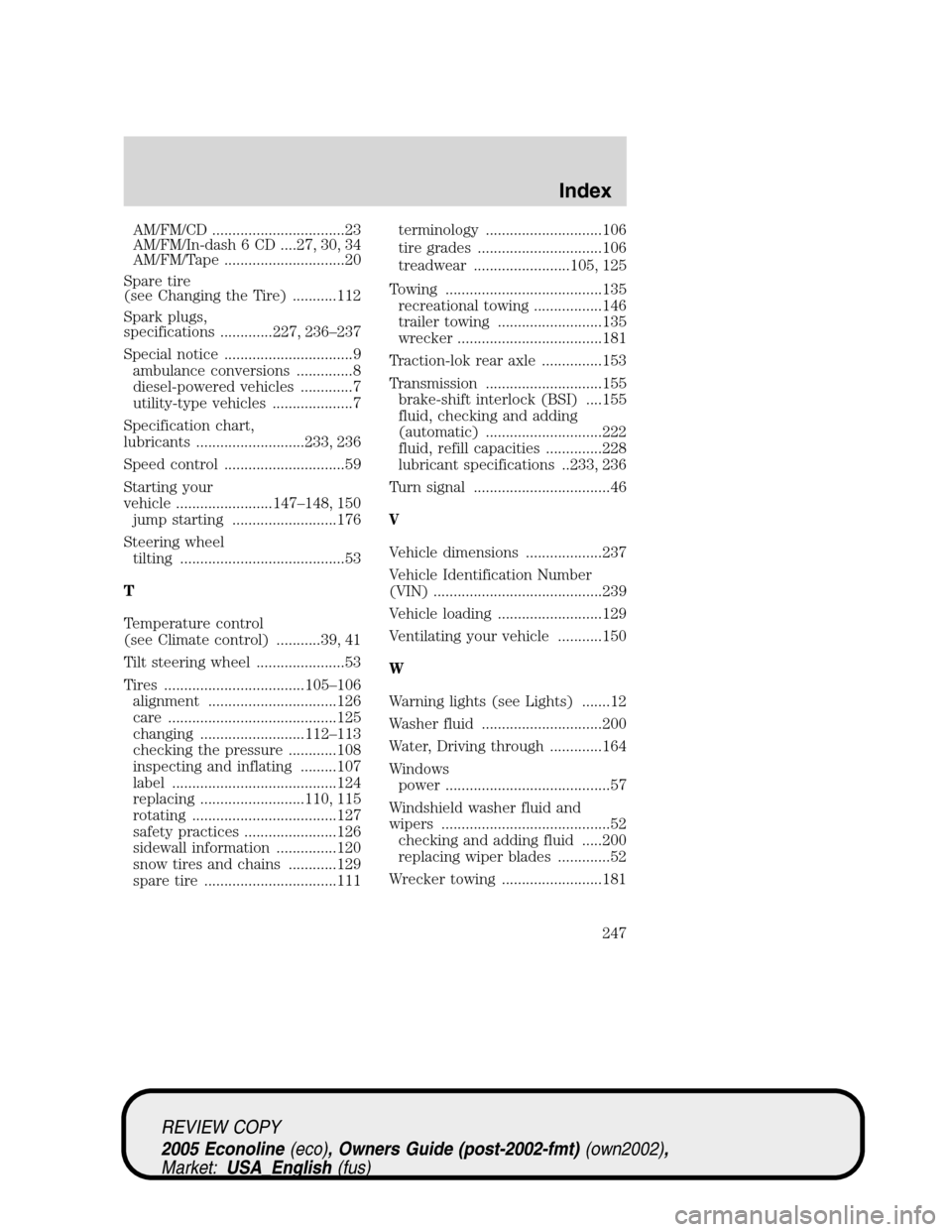warning FORD E SERIES 2005 4.G Owner's Manual
[x] Cancel search | Manufacturer: FORD, Model Year: 2005, Model line: E SERIES, Model: FORD E SERIES 2005 4.GPages: 248, PDF Size: 5.53 MB
Page 152 of 248

Parking brake
To set the parking brake (1), press
the parking brake pedal down until
the pedal stops.
To release, pull the lever (2).
Always set the parking
brake fully and make sure
that the gearshift is securely
latched in P (Park).
The BRAKE warning lamp will
illuminate and will remain
illuminated until the parking brake
is released.
The parking brake is not recommended to stop a moving vehicle.
However, if the normal brakes fail, the parking brake can be used to stop
your vehicle in an emergency. Since the parking brake applies only the
rear brakes, the vehicle’s stopping distance will increase greatly and the
handling of your vehicle will be adversely affected.
STEERING
To prevent damage to the power steering system:
•Never hold the steering wheel at its furthest turning points (until it
stops) for more than a few seconds when the engine is running.
•Do not operate the vehicle with a low power steering pump fluid level
(If the fluid level is below the FULL COLD range on the dipstick).
If the power steering system breaks down (or if the engine is turned
off), you can steer the vehicle manually, but it takes more effort.
If the steering wanders or pulls, check for:
•an improperly inflated tire
•uneven tire wear
•loose or worn suspension components
•loose or worn steering components
•improper steering alignment
P!
BRAKE
REVIEW COPY
2005 Econoline(eco), Owners Guide (post-2002-fmt)(own2002),
Market:USA_English(fus)
Driving
152
Page 155 of 248

•If the vehicle goes from one type of surface to another (i.e., from
concrete to gravel) there will be a change in the way the vehicle
responds to a maneuver (steering, acceleration or braking). Again,
avoid these abrupt inputs.
AUTOMATIC TRANSMISSION OPERATION
Brake-shift interlock
This vehicle is equipped with a brake-shift interlock feature that prevents
the gearshift lever from being moved from P (Park) when the ignition is
in the ON position unless brake pedal is depressed.
If you cannot move the gearshift lever out of P (Park) with ignition in
the ON position and the brake pedal depressed:
1. Apply the parking brake, turn ignition key to LOCK, then remove the
key.
2. Insert the key and turn it to OFF.Apply the brake pedal and shift
to N (Neutral).
When the key is in the ignition and in the OFF position, the
automatic transmission shift lever can be moved from the P
(Park) position without the brake pedal depressed. To avoid unwanted
vehicle movement, always set the parking brake.
3. Start the vehicle.
If it is necessary to use the above procedure to move the gearshift lever,
it is possible that a fuse has blown or the vehicle’s brakelamps are not
operating properly. Refer toFuses and relaysin theRoadside
Emergencieschapter.
Do not drive your vehicle until you verify that the brakelamps
are working.
Always set the parking brake fully and make sure the gearshift is
latched in P (Park). Turn the ignition to the LOCK position and
remove the key whenever you leave your vehicle.
If the parking brake is fully released, but the brake warning lamp
remains illuminated, the brakes may not be working properly.
See your dealer or a qualified service technician as soon as possible.
REVIEW COPY
2005 Econoline(eco), Owners Guide (post-2002-fmt)(own2002),
Market:USA_English(fus)
Driving
155
Page 219 of 248

EMISSION CONTROL SYSTEM
Your vehicle is equipped with various emission control components and a
catalytic converter which will enable your vehicle to comply with
applicable exhaust emission standards. To make sure that the catalytic
converter and other emission control components continue to work
properly:
•Use only the specified fuel listed.
•Avoid running out of fuel.
•Do not turn off the ignition while your vehicle is moving, especially at
high speeds.
•Have the items listed in yourScheduled Maintenance Guide
performed according to the specified schedule.
The scheduled maintenance items listed in theScheduled Maintenance
Guideare essential to the life and performance of your vehicle and to its
emissions system.
If other than Ford, Motorcraft or Ford-authorized parts are used for
maintenance replacements or for service of components affecting
emission control, such non-Ford parts should be equivalent to genuine
Ford Motor Company parts in performance and durability.
Do not park, idle, or drive your vehicle in dry grass or other dry
ground cover. The emission system heats up the engine
compartment and exhaust system, which can start a fire.
Illumination of the
indicator, charging system warning light, fluid
leaks, strange odors, smoke or loss of engine power, could indicate that
the emission control system is not working properly.
Exhaust leaks may result in entry of harmful and potentially
lethal fumes into the passenger compartment.
Do not make any unauthorized changes to your vehicle or engine. By
law, vehicle owners and anyone who manufactures, repairs, services,
sells, leases, trades vehicles, or supervises a fleet of vehicles are not
permitted to intentionally remove an emission control device or prevent
it from working. Information about your vehicle’s emission system is on
the Vehicle Emission Control Information Decal located on or near the
engine. This decal identifies engine displacement and gives some tune up
specifications.
REVIEW COPY
2005 Econoline(eco), Owners Guide (post-2002-fmt)(own2002),
Market:USA_English(fus)
Maintenance and Specifications
219
Page 220 of 248

Please consult yourWarranty Guidefor complete emission warranty
information.
On board diagnostics (OBD-II)
Your vehicle is equipped with a computer that monitors the engine’s
emission control system. This system is commonly known as the On
Board Diagnostics System (OBD-II). This OBD-II system protects the
environment by ensuring that your vehicle continues to meet
government emission standards. The OBD-II system also assists the
service technician in properly servicing your vehicle. When theCheck
engine/Service engine soonlight illuminates, the OBD-II system has
detected a malfunction. Temporary malfunctions may cause yourCheck
engine/Service engine soonlight to illuminate. Examples are:
1. The vehicle has run out of fuel. (The engine may misfire or run
poorly.)
2. Poor fuel quality or water in the fuel.
These temporary malfunctions can be corrected by filling the fuel tank
with good quality fuel. After three driving cycles without these or any
other temporary malfunctions present, theCheck engine/Service engine
soonlight should turn off. (A driving cycle consists of a cold engine
startup followed by mixed city/highway driving.) No additional vehicle
service is required.
If theCheck engine/Service engine soonlight remains on, have your
vehicle serviced at the first available opportunity.
Readiness for Inspection/Maintenance (I/M) testing
In some localities, it may be a legal requirement to pass an I/M test of
the on-board diagnostics system. If yourCheck engine/Service engine
soonlight is on, refer to the description in theWarning lights and
chimessection of theInstrument Clusterchapter. Your vehicle may not
pass the I/M test with theCheck engine/Service engine soonlight on.
If the vehicle’s powertrain system or its battery has just been serviced,
the on-board diagnostics system is reset to a “not ready for I/M test”
condition. To ready the on-board diagnostics system for I/M testing, a
minimum of 30 minutes of city and highway driving is necessary as
described below:
•First, at least 10 minutes of driving on an expressway or highway.
•Next, at least 20 minutes driving in stop-and-go, city-type traffic with
at least four idle periods.
REVIEW COPY
2005 Econoline(eco), Owners Guide (post-2002-fmt)(own2002),
Market:USA_English(fus)
Maintenance and Specifications
220
Page 222 of 248

5. Recheck the fluid level on the dipstick. Do not add fluid if the level is
between the arrows in the FULL COLD range.
6. If the fluid is low, add fluid in small amounts, continuously checking
the level until it reaches the FULL COLD range. Be sure to put the
dipstick back in the reservoir.
BRAKE FLUID RESERVOIR
The fluid level will drop slowly as
the brakes wear, and will rise when
the brake components are replaced.
Fluid levels below the “MAX” line
that do not trigger the brake system
warning lamp are within the normal
operating range, there is no need to
add fluid. If the fluid levels are outside of the normal operating range,
the performance of your brake system could be compromised, seek
service from your dealer immediately.
DRIVELINE UNIVERSAL JOINT AND SLIP YOKE
Your vehicle may be equipped with universal joints that require
lubrication. Refer to theScheduled Maintenance Guidefor
maintenance intervals. If the original universal joints are replaced with
universal joints equipped with grease fittings, lubrication will also be
necessary.
TRANSMISSION FLUID
Checking automatic transmission fluid (if equipped)
Refer to yourScheduled Maintenance Guidefor scheduled intervals for
fluid checks and changes. Your transmission does not consume fluid.
However, the fluid level should be checked if the transmission is not
working properly, i.e., if the transmission slips or shifts slowly or if you
notice some sign of fluid leakage.
Automatic transmission fluid expands when warmed. To obtain an
accurate fluid check, drive the vehicle until it is at normal operating
temperature (approximately 30 km [20 miles]). If your vehicle has been
operated for an extended period at high speeds, in city traffic during hot
weather or pulling a trailer, the vehicle should be turned off for about 30
minutes to allow fluid to cool before checking.
1. Drive the vehicle 30 km (20 miles) or until it reaches normal operating
temperature.
M
AX
REVIEW COPY
2005 Econoline(eco), Owners Guide (post-2002-fmt)(own2002),
Market:USA_English(fus)
Maintenance and Specifications
222
Page 243 of 248

A
Accessory delay ..........................57
Air bag supplemental restraint
system ..........................................83
and child safety seats ..............85
description ................................83
disposal ......................................87
driver air bag ............................85
indicator light ...........................87
operation ...................................85
passenger air bag .....................85
Air cleaner filter ...............226–227
Ambulance packages ....................8
Antifreeze
(see Engine coolant) ................205
Anti-lock brake system
(see Brakes) ..............................151
Audio system
(see Radio) ....18, 20, 22, 25, 28, 33
Automatic transmission
driving an automatic
overdrive .................156, 158, 161
fluid, adding ............................222
fluid, checking ........................222
fluid, refill capacities ..............228
fluid, specification ..................236
Auxiliary power point .................56
Axle
lubricant specifications ..233, 236
refill capacities ........................228
traction lok ..............................153
B
Battery .......................................203
acid, treating emergencies .....203
jumping a disabled battery ....176
maintenance-free ....................203replacement, specifications ...227
servicing ..................................203
BeltMinder ...................................78
Brakes ........................................151
anti-lock ...................................151
anti-lock brake system (ABS)
warning light ...........................151
fluid, checking and adding ....222
fluid, refill capacities ..............228
fluid, specifications .........233, 236
lubricant specifications ..233, 236
parking ....................................152
shift interlock ..........................155
Break-in period .............................5
Bulbs ............................................47
C
Capacities for refilling fluids ....228
Cell phone use ............................56
Child safety restraints ................88
child safety belts ......................88
Child safety seats ........................91
in front seat ..............................92
in rear seat ................................92
tether anchorage hardware .....95
Cleaning your vehicle
engine compartment ..............193
exterior ....................................195
instrument panel ....................194
interior .....................................195
interior trim ............................194
plastic parts ............................193
safety belts ..............................195
washing ....................................191
waxing .....................................191
wheels ......................................192
wiper blades ............................194
REVIEW COPY
2005 Econoline(eco), Owners Guide (post-2002-fmt)(own2002),
Market:USA_English(fus)
Index
Index
243
Page 246 of 248

headlamps, flash to pass ..........43
instrument panel, dimming .....43
interior lamps ...........................46
replacing bulbs ...................47–51
Lane change indicator
(see Turn signal) ........................46
Lights, warning and indicator ....12
anti-lock brakes (ABS) ..........151
Load limits .................................129
Loading instructions .................134
Lubricant specifications ...233, 236
Lug nuts ....................................119
Lumbar support, seats ...............68
M
Mirrors
fold away ...................................58
side view mirrors (power) .......57
Motorcraft parts ................215, 227
O
Octane rating ............................214
Oil (see Engine oil) ..................200
P
Parking brake ............................152
Parts (see Motorcraft parts) ....227
Power distribution box
(see Fuses) ...............................171
Power door locks ........................62
Power mirrors .............................57
Power point .................................56
Power steering ..........................152
fluid, checking and adding ....221fluid, refill capacity ................228
fluid, specifications .........233, 236
Power Windows ...........................57
Preparing to drive your
vehicle ........................................153
R
Radio ..............18, 20, 22, 25, 28, 33
Relays ................................168, 174
Remote entry system
illuminated entry ................42, 66
locking/unlocking doors ...........62
Roadside assistance ..................165
S
Safety Belt Maintenance ............82
Safety belts
(see Safety restraints) .........73–77
Safety defects, reporting ..........190
Safety restraints ....................73–77
belt minder ...............................78
extension assembly ..................82
for adults .............................74–76
for children .........................87–88
lap belt ......................................77
safety belt maintenance ...........82
warning light and chime ..........78
Safety seats for children ............91
Seat belts
(see Safety restraints) ...............73
Seats ............................................67
child safety seats ......................91
front seats .................................67
Servicing your vehicle ..............197
Setting the clock
AM/FM stereo ...........................19
REVIEW COPY
2005 Econoline(eco), Owners Guide (post-2002-fmt)(own2002),
Market:USA_English(fus)
Index
246
Page 247 of 248

AM/FM/CD .................................23
AM/FM/In-dash 6 CD ....27, 30, 34
AM/FM/Tape ..............................20
Spare tire
(see Changing the Tire) ...........112
Spark plugs,
specifications .............227, 236–237
Special notice ................................9
ambulance conversions ..............8
diesel-powered vehicles .............7
utility-type vehicles ....................7
Specification chart,
lubricants ...........................233, 236
Speed control ..............................59
Starting your
vehicle ........................147–148, 150
jump starting ..........................176
Steering wheel
tilting .........................................53
T
Temperature control
(see Climate control) ...........39, 41
Tilt steering wheel ......................53
Tires ...................................105–106
alignment ................................126
care ..........................................125
changing ..........................112–113
checking the pressure ............108
inspecting and inflating .........107
label .........................................124
replacing ..........................110, 115
rotating ....................................127
safety practices .......................126
sidewall information ...............120
snow tires and chains ............129
spare tire .................................111terminology .............................106
tire grades ...............................106
treadwear ........................105, 125
Towing .......................................135
recreational towing .................146
trailer towing ..........................135
wrecker ....................................181
Traction-lok rear axle ...............153
Transmission .............................155
brake-shift interlock (BSI) ....155
fluid, checking and adding
(automatic) .............................222
fluid, refill capacities ..............228
lubricant specifications ..233, 236
Turn signal ..................................46
V
Vehicle dimensions ...................237
Vehicle Identification Number
(VIN) ..........................................239
Vehicle loading ..........................129
Ventilating your vehicle ...........150
W
Warning lights (see Lights) .......12
Washer fluid ..............................200
Water, Driving through .............164
Windows
power .........................................57
Windshield washer fluid and
wipers ..........................................52
checking and adding fluid .....200
replacing wiper blades .............52
Wrecker towing .........................181
REVIEW COPY
2005 Econoline(eco), Owners Guide (post-2002-fmt)(own2002),
Market:USA_English(fus)
Index
247